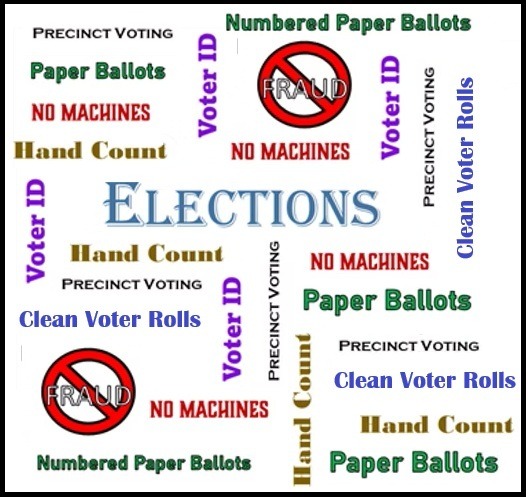
Refuting the Hand-Count Critics
Is hand counting a practical solution for complex, high turnout elections? Or are we stuck with tabulators? Let's run the numbers to see if the Truly Transparent Tabulation team can handle the "Worst Case Scenario" put forth by Hand Counting Critics.
6/28/20258 min read
Eye on Elections volunteers recently conducted a Mock Precinct Count in order to demonstrate that an efficient, transparent system of hand-counting could be a practical alternative to riggable electronic tabulators. The method of hand-counting they used is described in the article, A Truly Transparent Tabulation System (TTT).
In this article we evaluate the results of the Mock Precinct Count, in terms of efficiency, accuracy, speed, and other factors in order to determine if the TTT system of hand-counting is a practical alternative to machine tabulation.
Proof by Demonstration
The reason it was necessary to walk through the entire process of hand counting a precinct, while keeping track of the time and resources necessary to complete each task, was that critics of hand counting claim that hand counting is simply impossible for high turnout elections. They argue that hand counting is impractical, tedious, error prone, and takes enormous resources, and that electronic tabulators are essential to modern elections.
Such claims cannot be refuted without hard data. It was necessary to demonstrate that critics were exaggerating the difficulties of hand counting, by providing a real-life example of an efficient, transparent hand-count.
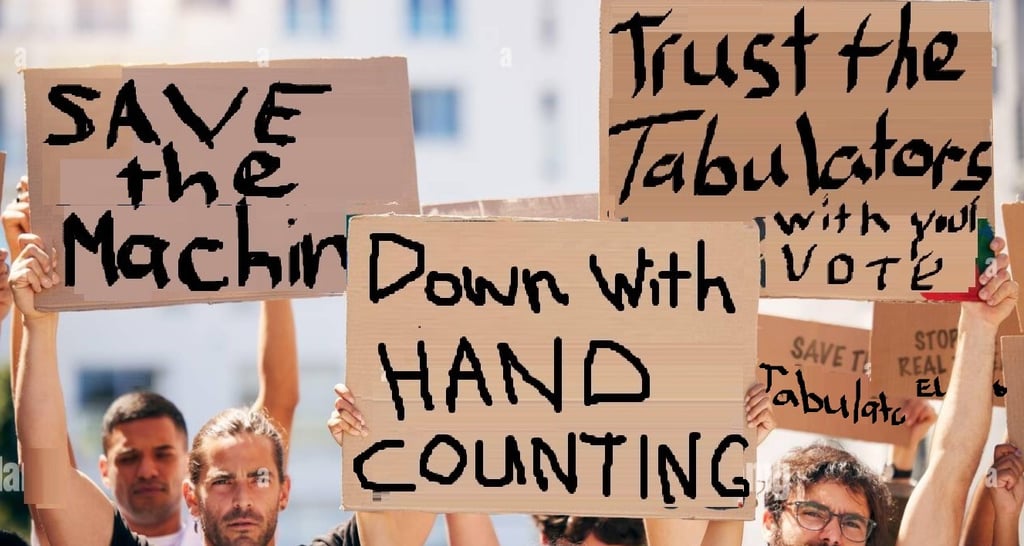

For example, in a recent article proposing further investments in tabulators, Brent Regan claims:
“Hand counting is practical for simple ballots or elections with a small number of ballots, but large elections with complex, multi-issue ballots present a huge logistics problem. . . . Imagine there are 20 issues on the ballot so that each ballot takes two minutes for four people to tabulate (2 counters and 2 observers). In our county we cast 97,911 ballots in the presidential election at 74 precincts. That is over 1,300 ballots to count which would take four people 44 hours or 40 people about 5 hours, at each precinct.“
To be clear, Regan is claiming that a four person team must take two minutes to read a 20-contest ballot. This works out to 8 man-minutes per ballot, which, if multipled by 1300 ballots, works out to 175 man-hours to count a single precinct. On this basis Regan justifies further investments in corruptible electronic tabulators.
These are the numbers we need to beat to prove that the Truly Transparent Tabulation system is a better alternative. Let’s see if the Eye on Elections team can do better. . .
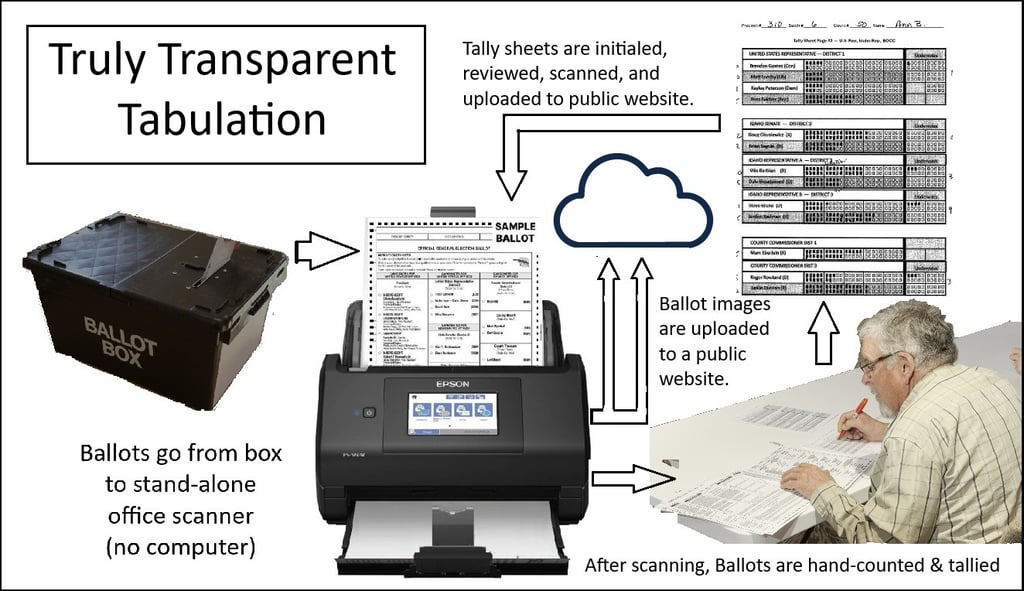

In previous years, hand counting of ballots has primarily been done in the case of recounts, and for the purpose of auditing machine counts. In virtually all cases, however, the results reported by electronic tabulators are consistent with the ballot images produced by the electronic tabulators. Why then, is a hand count necessary in these cases?
The reason neither official recounts nor audits can rely on ballot images produced by tabulation machines is that their authenticity is the issue at stake. Electronic tabulators combine the process of scanning ballots and tabulating them, so if the tabulator has been rigged, neither the results, nor the ballot images, can be trusted. This makes either fraud or errors in tabulation extremely difficult to detect, and numerous witnesses are needed for any meaningful recount.
When the public has no access to reliable ballot images, two tabulators and two witnesses are necessary to verify a hand-count. But when the verified ballot images are publicly available shortly after the polls close, any errors in the counting process can easily be found, so a single counter is sufficient. There is nothing mysterious about why the TTT method of hand counting is so efficient. It relies on verifiable ballot images rather than multiple witnesses to assure accuracy.
This is the key to understanding the TTT. The goal is not just to get rid of riggable electronic tabulators, but to replace them with a Truly Transparent Tabulation System.
Understanding the Truly Transparent Tabulation System
Before running the numbers on the Mock Precinct Count, we need to be familiar with the system of tabulation that was used. The cornerstone of Truly Transparent Tabulation is not hand counting; it is securely photocopying ballots and releasing valid, verified ballot images for public view.
The first priority of the TTT system is transparency, and in a previous article, we described how TTT guarantees that reliable ballot images are generated. The reason this is important is because having easy access to valid ballot images changes the dynamics of what is required to verify the accuracy of hand tabulation.
Mock Precinct Count Results
The Mock Precinct Count was designed to go through the whole process of opening the ballot box, sorting and scanning ballots, uploading ballot images to a public website, counting batches of ballots, entering the data into a spreadsheet, spot-checking close races, and uploading tally sheets and final results. The entire process has been discussed in a previous article, and here we are only reporting the results.
The Eye on Elections team included eight volunteers, with one designated judge and seven counters. The team counted 656 ballots—each with 13 contests. The ballots were divided into batches of 50, resulting in 13 full size batches and a 14th batch of only 6. Each counter counted only batches (or 100 ballots), and the initial counting took just over two hours. The entire process was completed—including counting and uploading ballot images, tally sheets and result files—in just over three hours, and it would have likely gone even faster with an additional counting judge.
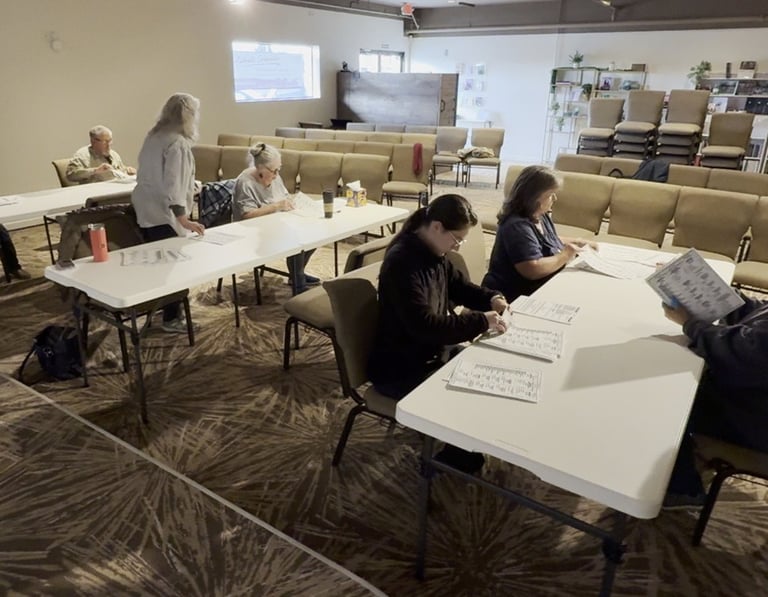

Tallying Rates—Throughout the Mock Precinct trial, hand counters were consistently able to tally at the rate of about 5 seconds per contest, or one (13 contest) ballot per minute. On average it took the TTT team 51 minutes to count 50 ballots, but there was a significant variation in tallying times.
Counting times for 650 ballots divided into 13 batches of 50 were: 67, 66, 58, 56, 55, 54, 50, 45, 44, 43, 42, 40, 37 minutes.
These numbers do not include the time spent sorting ballots, waiting to scan ballots, taking breaks, doing spot checks, or waiting for the judge’s attention. These were counting times only, but they are sufficent for evaluating how the Eyes on Elections team did in two metrics of interest: 1) Projected time and manpower needed for a high turnout election, and 2) Accuracy and Verifiability.
Regan’s Worst Case Scenario
Regan's worst-case numbers for a high-turnout, high-ballot-issue election were given above. He estimates that a federal electon could have up to 20 issues per ballot, and 1300 ballots may need to be counted per precinct.
The TTT team's Mock Precinct counted about half as many ballots, and they averaged 51 minutes for each 50-ballot batch, covering 13 contests. This means they would likely average about 80 minutes per batch for a ballot with 20 contests (Multiply 51 by 20/13). And 1300 ballots means that 26 batches of 50 would have to be counted.
So, factoring in 10-15 minute breaks between batches, we can assume each counter could count one batch in about 90 minutes. Assuming we are working with a team of seven counters and two judges, each counter would need to count 3 or 4 batches, which would take no more than six hours. Meanwhile the judges would scan, upload batch files, enter data into spreadsheets, spot-count specific races, and assist the counters as needed.
In this scenario, with a team of 9, all ballots could be counted and results reported in six hours or less, meaning 54 man-hours to count 1300 20-issue ballots. This is less than one third the time Regan estimates (175 man hours), and it includes the manpower necessary to sort, scan, upload, enter data, and spot check, and adjudicate as well as count. Even break times and general inefficiencies have been factored into these numbers.
And this is Regan's WORST CASE SCENARIO. In lower turnout elections, hand counting could be done by a team of four or five in just a few hours.
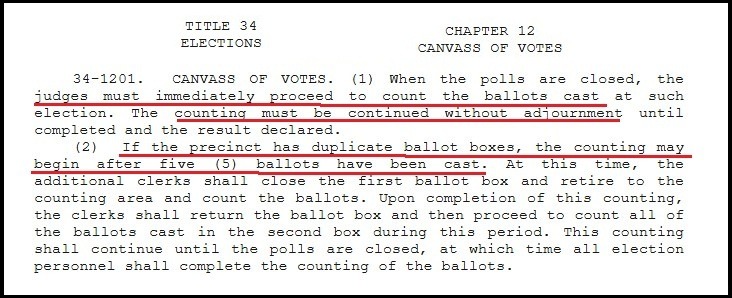

But that's not all!!!. Idaho law explicitly allows hand counting to commence BEFORE the polls close (using two ballot boxes). If this were done, counting could begin in the afternoon, and final results could be posted shortly after the polls close, even for a “Worst Case” high turnout, high ballot issue elections.
But the truth is, Idaho statutes governing elections were written to provide for efficient, accurate hand-counting at the polling stations, and everything the TTT method proposes is in perfect accord with the original intent of Idaho election laws. TTT is not innovation—it is returning to basic principles. It is the statutes governing computerized elections that have been added haphazardly in recent years, and most are not well thought out, and allow opportunity for fraud.
What About Accuracy?
Even if hand-counting critics conceded the efficiency of the TTT system, they may attempt to dismiss manual tabulation as being less than perfectly accurate. And in truth, hand counting can be prone to minor errors.
But minor errors rarely alter the final outcome, and counting judges can be instructed to double check close, critical races. But most importantly, the fact that the TTT method makes all ballots publicly viewable immediately after the polls close, means that if mistakes are made in a close race, they will certainly be caught.
So how did the TTT team do in terms of accuracy? The initial vote totals for the entire precinct differed by 13 votes across all races, after checksums errors from all 14 batches were resolved. (Compare original candidate total and amended final tally to see the difference).
In terms of percentages, a total of 5828 votes were cast for candidates in which checksums were used to verify accuracy. This amounts to a (minimum) error rate of 13 out of 5828 or 0.2%, so even before correcting errors, the TTT team was within the acceptable standard of accuracy (less than one quarter of one percent), that Idaho statutes allows for MACHINE tabulation in official recounts.
Even with this good record of accuracy, initial vote totals reported by hand- counted precincts may have minor errors in initial tabulation or data entry. But TTT counting judges can be trained to investigate irregularities, and to recount races that appear to have errors, or are very close.
More importantly, when considering comparison of the accuracy of machine-counts vs. hand-counts, it's important to consider a machine's claims of accuracy are verifiable. Logic and Accuracy tests are considered valid tests for electronic tabulators because the correct results are known ahead of time, but when tabulators count real elections the results are never verified in full.
It is meaningless to claim that electronic tabulators are accurate, for their results cannot be verified, because the ballot images they produce are NEVER checked against the physical ballots.
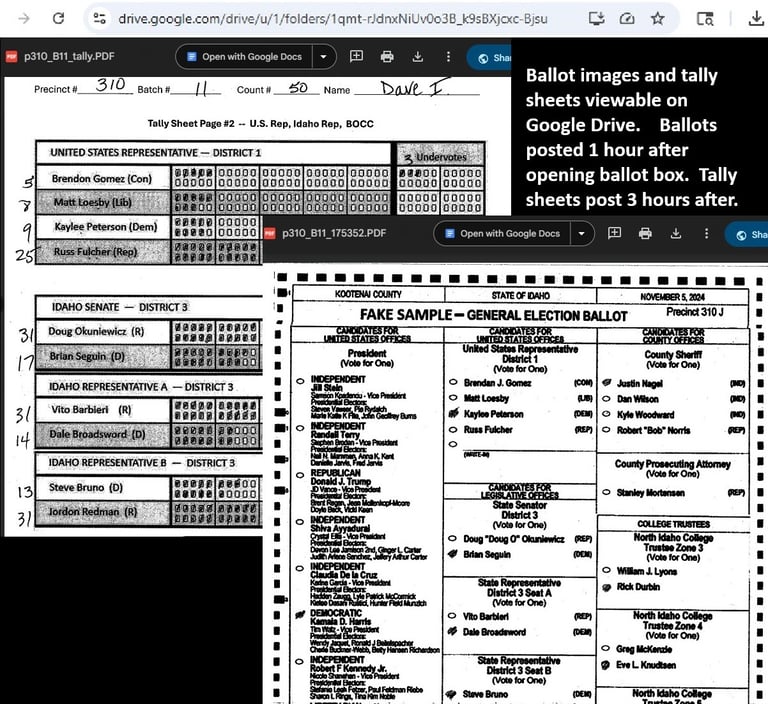

It might also be claimed that the TTT system is open to fraud because counters may intentionally miscount certain races. This is possible, but the tally sheets assigned to each batch are initialed by both the judge and the counter, and the names of people responsible for counting each precinct are a matter of public record.
So bad actors could falsify tally sheets in a few cases, but why would they, when they have a 100% chance of being identified and caught?
The TTT method of hand counting is not only efficient, it is practically cheat-proof and error-proof. Since all election data is made public immediately, cheaters are unable to manipulate data, swap in fake ballots, or disguise their shenanigans, and honest errors can easily be corrected.
Claims of accuracy that cannot be verified are meaningless, and full transparency prevents fraud before it happens.
If you would like to learn more about Election Fraud in Idaho and possible solutions, please subscribe to the Eye on Elections newsletter, by filling in the form below.
Empowering Voters
Advocating for transparent, honest, and decentralized voting systems.
Please subscribe to the Eye on Elections Newsletter.
Contact us:
© 2025. All rights reserved.
